Kingston HyperX Cloud Core. Removing too much
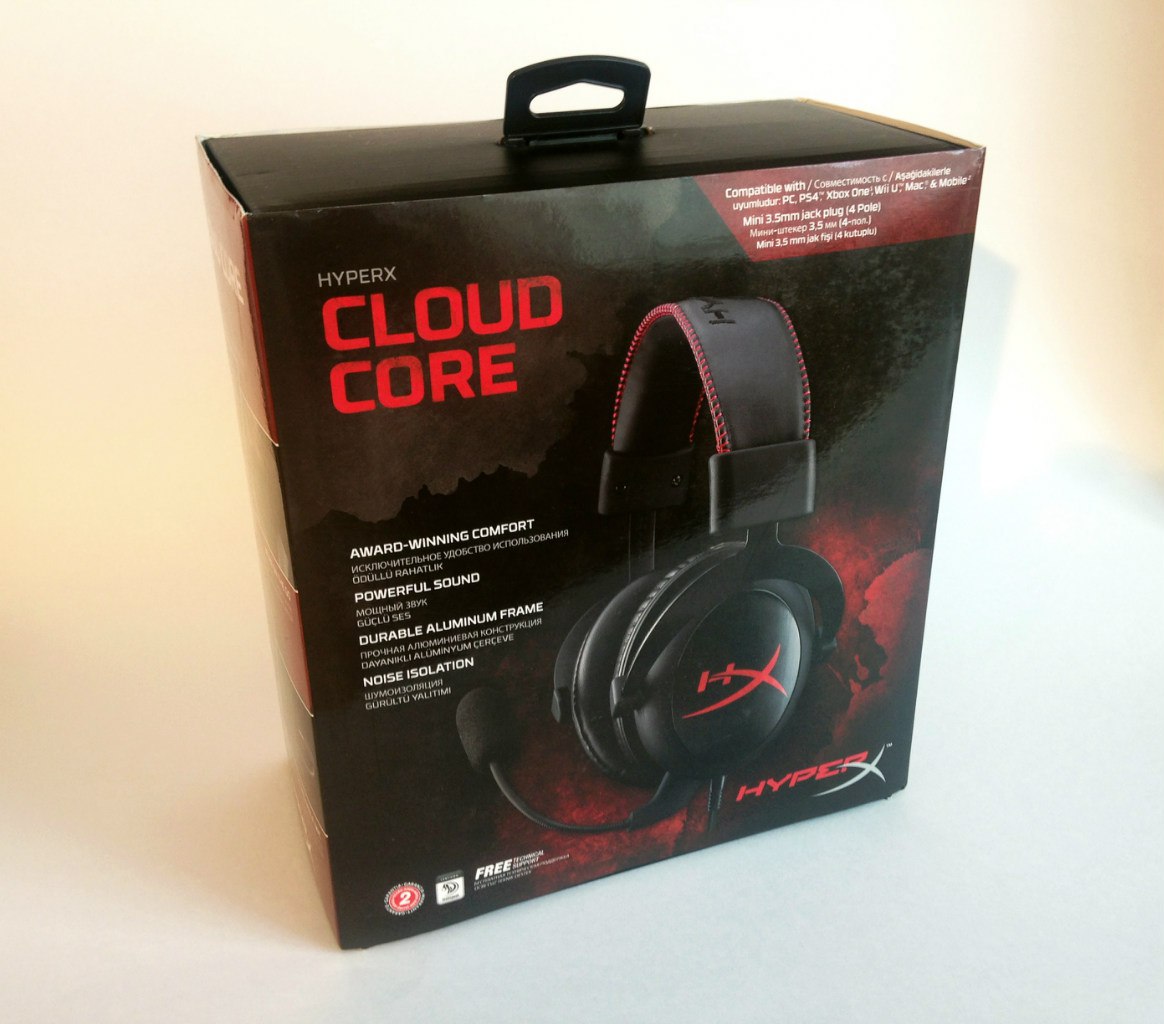
At the present time, the Kingston company monitors the actively developing peripheral market, producing suitable devices (at the moment - headsets and carpets), gradually grabbing off part of the market. I personally observe how the line of gaming headsets is gaining popularity, as many advise it when choosing a headset in terms of price / quality ratio.
The new headset Kingston HyperX Cloud Core is the youngest model in the entire line. And the cheapest, by the way. But this does not mean that the sound quality has suffered. On the contrary, Kingston decided to just - let’s leave a good sound in the headphones, the same microphone, and remove all unnecessary - a complete set. That is, the same sound and voice quality is declared as in previous models of the line.
')
But how will this headset manifest itself and to whom is it aimed? What is the feature of the gaming headset? Let's try to figure everything out. 2 audio samples recorded from a microphone are included.
Content:
All images in the text have high resolution.
Getting to know the headset [ ↑ ]
At first I decided to write all the technical characteristics of the ears, because not all the full information is indicated (resistance and characteristics of the microphone, for example), but as it turned out, there is no need to go far, and all the information is already in the announcement of this headset . So a complete description of all the characteristics of the headset is given by reference, and I propose to focus on studying it.
Where did these headphones come from? Some analytics
In fact, there is just a huge line. Studying this question, I even got a little confused, because the Kingston headphones are not their own design, but an OEM product that is very well reworked. The headphones themselves originate in the QPad QH-90 headset, however, the QPad is an OEM product. Most likely, Takstar Pro 80 headphones were their predecessor. QPad simply removed the gloss from the cups and turned on the microphone, which made the headphones become a headset, moreover, more unpretentious in care. But there is information that ... OEM headphones Takstar Pro 80 - Gemini DJ HSR-1000.
This chain can reach very far, but all of them borrow something from each other and find a beginning rather difficult. Information for mere mortals, most likely, is not available, so there are only guesses. In addition, if you look closely at the shape of the cups, then only one company comes to mind - Beyerdynamic. In my opinion, they were the first in their DT 770/880/990 lines to use this mount (as a slingshot), it turned out to be successful and very reliable, so the rest decided to “borrow” it. I see nothing wrong with that. These are just my observations that do not pretend to be true. If you look at the same QPad QH-1339 headset, you will see how strikingly they look like a Beyerdynamic DT 770 Pro headset or a Beyerdynamic DT 790.00 headset.
The difference in the sound of any Cloud, Takstar, QPad and others, most likely, will be insignificant (or it will not exist at all), since there probably are the same speakers. Unless markings and revisions may differ, but structurally the dynamics will be similar. Or maybe all the speakers are taken from one factory. Moreover, from a dialogue with one person, keenly interested in peripherals and owning Takstar Pro 80 headphones, I found out that the sound of the HyperX Cloud and Takstar Pro 80 is identical (judging by the description). I will tell you about the sound itself later, it's just a kind of confirmation of my observations.
So why exactly HyperX Cloud? It's simple. Takstar and the same Gemini are generally just headphones without a microphone, and they are also quite brandy and comparable in price to HyperX Cloud Core, while the QPad is not sold in Russia, so this is a reasonable option in conjunction with headphones + microphone.
This chain can reach very far, but all of them borrow something from each other and find a beginning rather difficult. Information for mere mortals, most likely, is not available, so there are only guesses. In addition, if you look closely at the shape of the cups, then only one company comes to mind - Beyerdynamic. In my opinion, they were the first in their DT 770/880/990 lines to use this mount (as a slingshot), it turned out to be successful and very reliable, so the rest decided to “borrow” it. I see nothing wrong with that. These are just my observations that do not pretend to be true. If you look at the same QPad QH-1339 headset, you will see how strikingly they look like a Beyerdynamic DT 770 Pro headset or a Beyerdynamic DT 790.00 headset.
The difference in the sound of any Cloud, Takstar, QPad and others, most likely, will be insignificant (or it will not exist at all), since there probably are the same speakers. Unless markings and revisions may differ, but structurally the dynamics will be similar. Or maybe all the speakers are taken from one factory. Moreover, from a dialogue with one person, keenly interested in peripherals and owning Takstar Pro 80 headphones, I found out that the sound of the HyperX Cloud and Takstar Pro 80 is identical (judging by the description). I will tell you about the sound itself later, it's just a kind of confirmation of my observations.
So why exactly HyperX Cloud? It's simple. Takstar and the same Gemini are generally just headphones without a microphone, and they are also quite brandy and comparable in price to HyperX Cloud Core, while the QPad is not sold in Russia, so this is a reasonable option in conjunction with headphones + microphone.
Acquaintance begins with a large box. The black box is inside the sleeves of thick glossy cardboard. The sleeve is made in black and red colors, the image of headphones is printed on the sleeve itself and various information is located on all sides. In the front are the main characteristics, on the sides are the features and names of the organizations that use this headset, in the back is a more detailed description of all the ear chips and information about the Kingston two-year warranty. I will not read this, there is nothing of great importance.
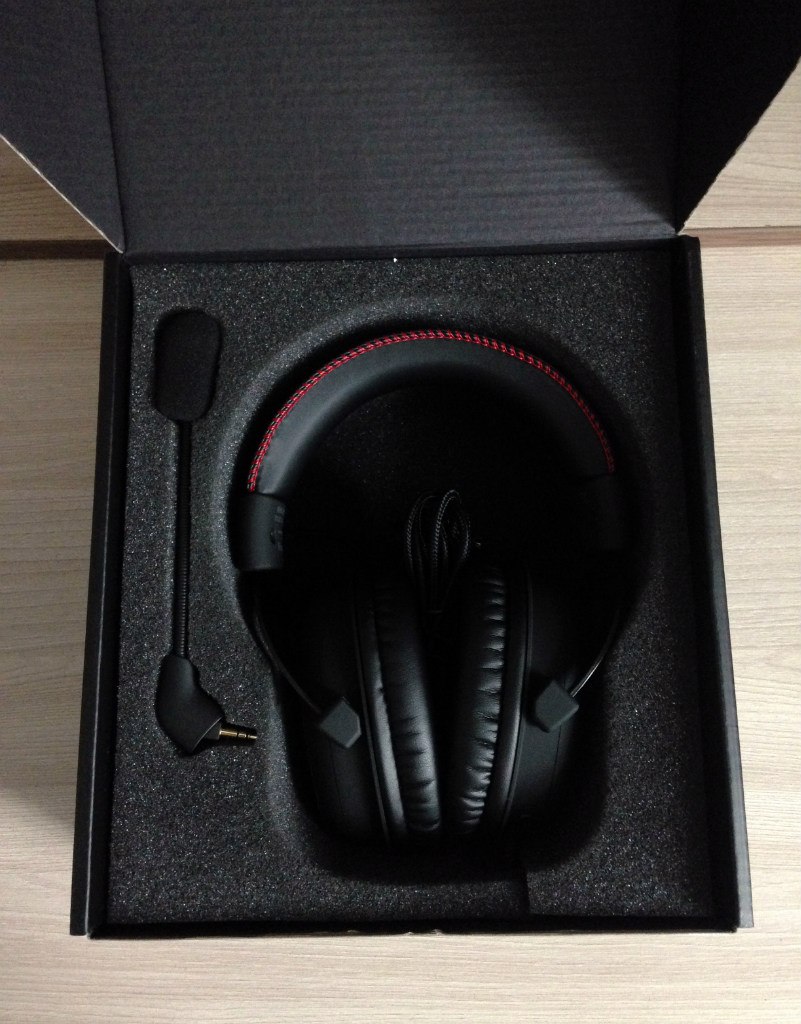
There are no inscriptions on the black cardboard box, and the box itself has a simple flip cover. Unlike the first Cloud model, there is nothing at all on the box - neither labels, nor greetings on the lid inside. Here, too, removed all unnecessary. Two pieces of paper fall out of the box at once - one with support and sites (useless) and a piece of paper with connection to various devices (more or less useful, illustrated). Inside, everything is covered with foam rubber for the preservation of headphones and accessories.
There is also a complete set, which turned out to be extremely scarce - headphones, a microphone and an adapter with 4-pin 3.5 mm jack to 2x 3.5 mm jack for separate connection of headphones and a microphone to the motherboard on a computer or external sound card, for example. No extra velor cushions that came with the first Cloud, no pouch to carry. Headphones, microphone and extension adapter. That's all the equipment. Little, very little. But it will be appreciated by those who do not need any bells and whistles, and the Cloud Core headset is the most budget in the entire line.
I have a double impression: on the one hand, it is really not very necessary, but on the other ... All adapters are easily bought on the electronics market, and you can even choose any length of adapters, but to find a good bag for headphones or a new ear cushion will be difficult. We'll have to contact the Chinese colleagues with their famous shops. And given that the family of headphones with this form of cups is quite popular (see the spoiler above), it will not be difficult to acquire such ones.
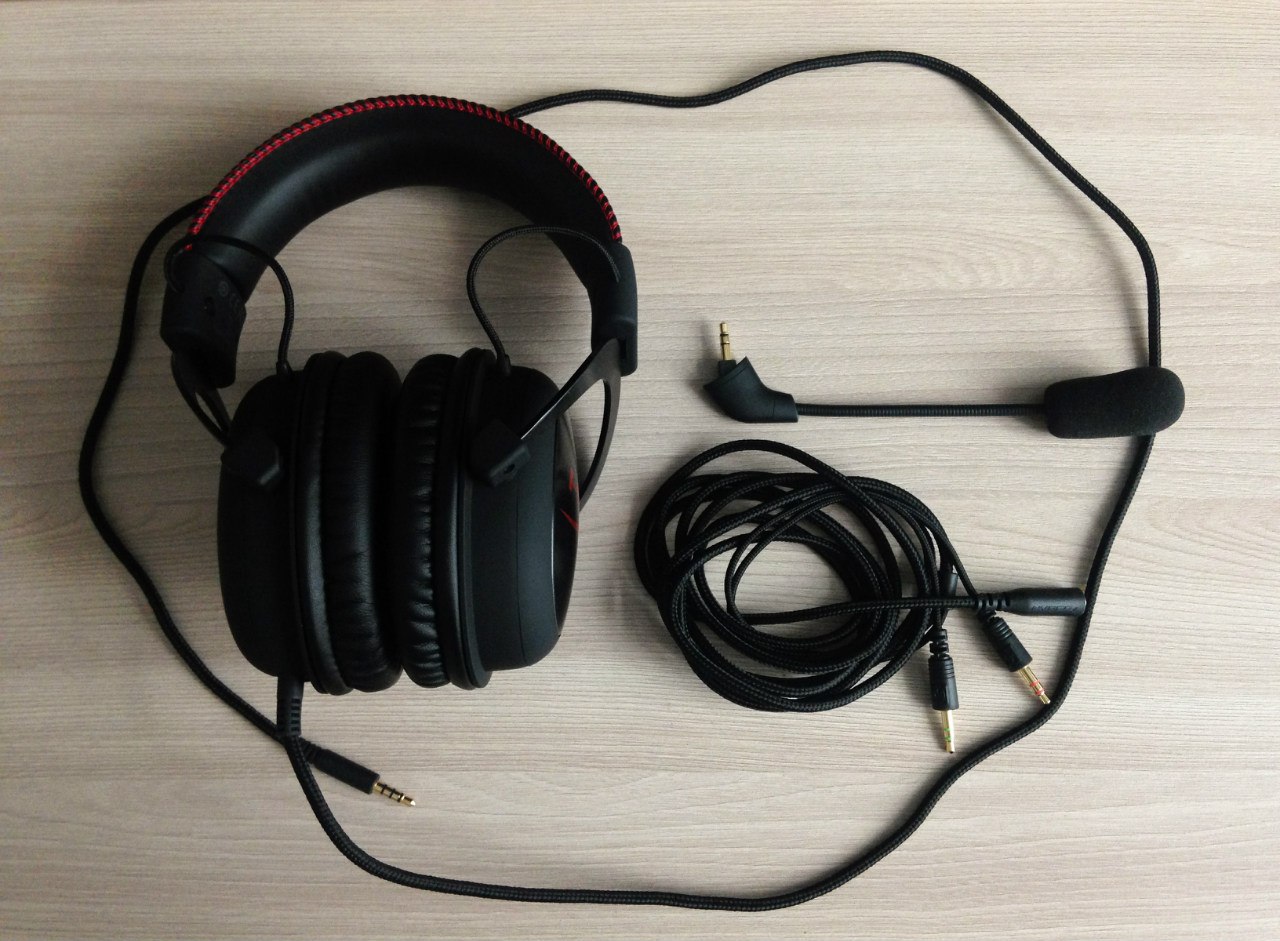
What are the differences from other headphones in the HyperX Cloud line?
Compared to the first headset, the headphones have one wire 1.1 meters long, ending in a 4-pin 3.5 mm jack, whereas the first at the end had two wires - one for the ears and one for the microphone; also the first Cloud had much more complete set. Compared to Cloud II, the headphones themselves and the microphone are no different (the noise-canceling nozzle has a slightly different shape, this does not affect the voice transmission), however, Cloud II comes bundled with a sound card that allows headphones to work via USB, and it also supports virtual 7.1 sound mode. About 7.1, I will say a few words later, but everything else is the same. That is, there are no differences between the headphones and the microphone themselves. All that has changed is the equipment, colors and, of course, the price. Well, also the wire from the headphones themselves in Cloud II and Cloud Core is one, not forked, like the first Cloud.
Design and ergonomics [ ↑ ]
The first thing that is felt after you get the headphones out of the box is the smell. Light smell of novelty, pleasant, noble. Headphones covering, they completely crawls ear - this is the type of headphones I love most. The microphone is connected to the left side next to the cable (you must first remove the cap from the microphone jack). It is inserted there tightly, from there it will not jump out anywhere.

The headphones themselves are made in black-gray-red tones. Moreover, the gray color is also quite dark, so the coloring turned out to be strict and neat, with red inserts in the form of the HyperX logo on the ear cups and red stitching on the headband. The aluminum parts are painted black - the sides of the cups and the aluminum arms on which these same cups are attached. The material of the cups themselves is soft-touch coating. The place where the earphones are included is done very carefully, no distortions, everything is very well adjusted. The material for fixing the entrance of the cups is also a soft-touch coating.
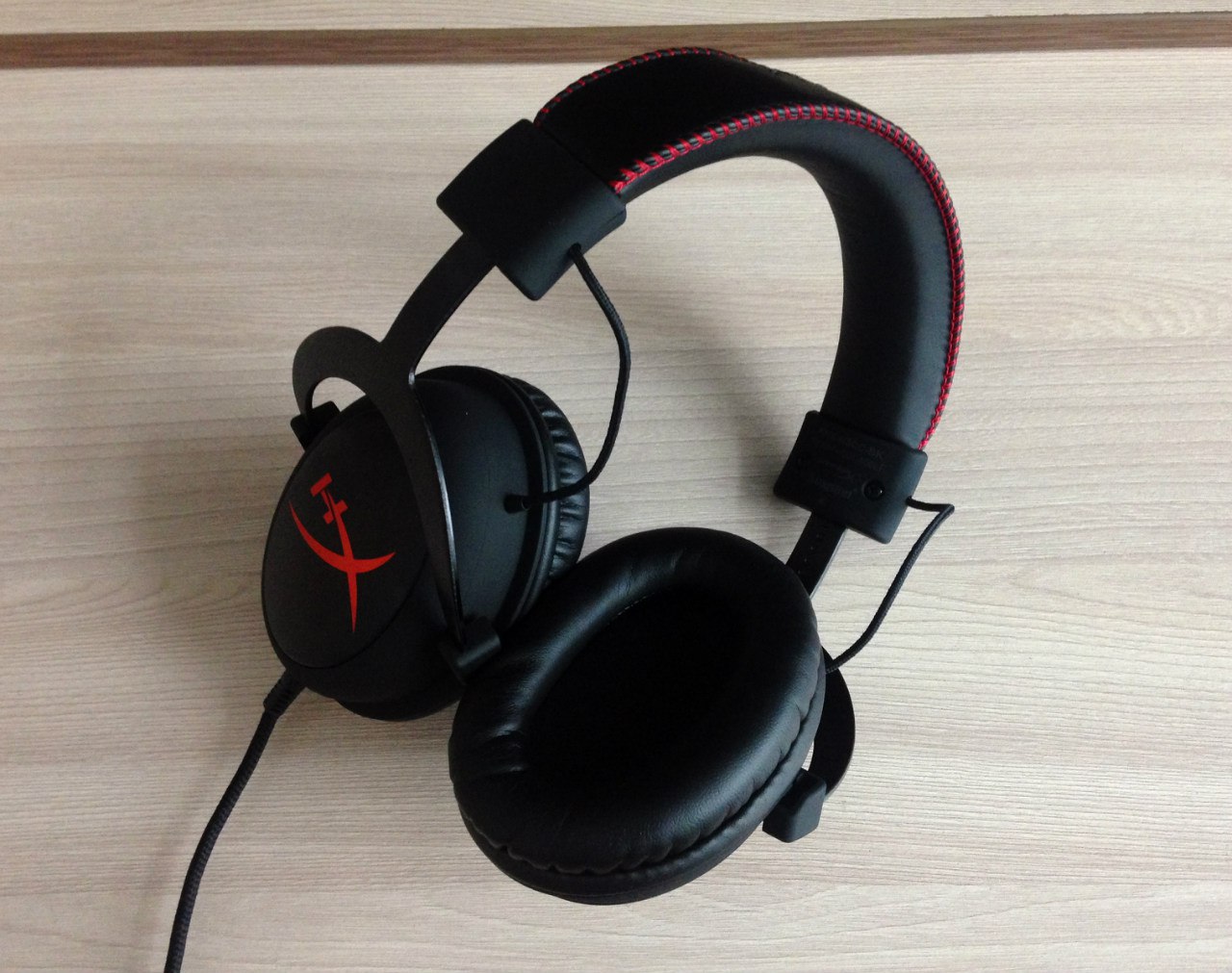
The cups are oval, the ear fits completely into them, the ear cushions on the cups are made of leatherette and they are very, very soft to the touch. Inside the ear cushions there is soft foam, because of which the cushions take the shape of the head. Inside the headphone cups there is a fabric mesh, which is also designed to provide comfort when using headphones. Headphone cushions are removable.

Headband is also very neat. It is soft, smooth, made of leatherette, it does not have the "wrinkled", which is often found in other headphones in various price categories. Pure visually looks nice. The headband is stitched with red thread, the stitching is very smooth. A HyperX logo is embroidered with a black thread on top of the headband.
Inside the headband is located, as I understand it, the aluminum frame, which makes these headphones are very reliable. It is impossible to uncover the headband itself, so that if it is polluted, it will have to be cleaned, and in general it should be handled with care, since no replacement can be found.

Near the cups, at the attachment points, there are no details (usually they are made in the form of points), which allow us to tactilely determine which side of the left earpiece is located. Although, in fairness it is worth noting that the headphone cable is located on the left side, so that even in the dark you will not confuse which side to put on the headphones.
The wire enters from the left side, at the entrance and at the end has protection against bending. The wire itself is rather soft and thick, in a fabric sheath, and at the same time does not remember the shape very readily. The braid will not allow the wire to get tangled or bend too much. The length of the wire is 1.1 meters, at the end of a 4-pin 3.5 mm jack. Additional adapter is also braided, its length is 2 meters, at the end of 2x 3,5 mm jack: with a green mark for headphones and with a pink one for a microphone. Maximum length - 3 meters with a small (consider plugs, which also give an extra ten centimeters). The wire connecting the ears (which goes from the left earpiece to the right through the headband) ... also braided. In general, all wires are braided.
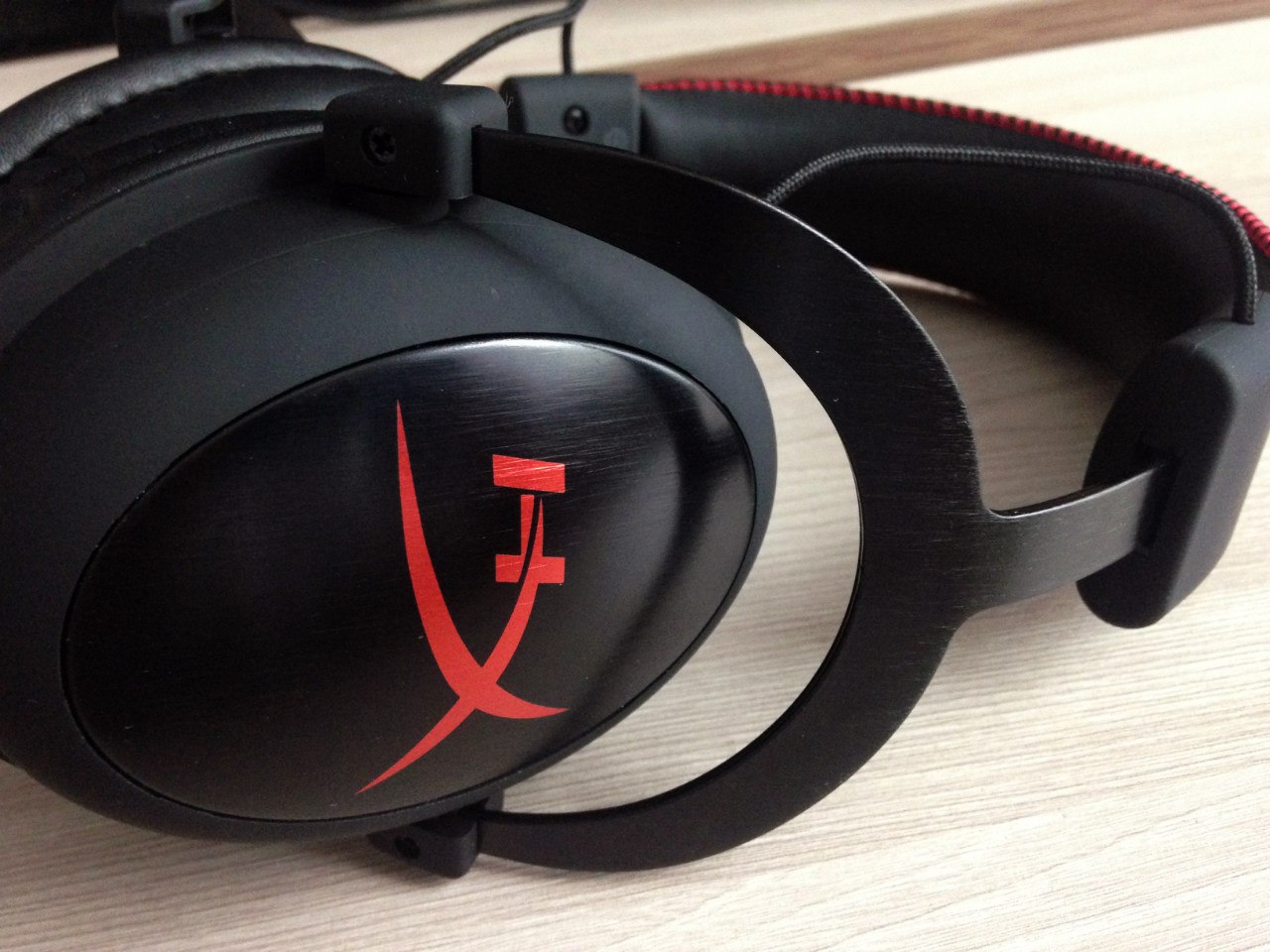
Headphones sit comfortably on the head, thanks to the soft ear cushions they are almost not felt, and the ears are nice. They don’t put pressure on their heads, but they don’t telepay anywhere. The pressure on the head is almost imperceptible, so there are no problems. The headphones themselves are closed, with good noise insulation, so that they will cut off most of the external noise, so sometimes you can skip a call or someone's call. But at the same time, no one will hear what is playing now in the ears. Plus for those who like to sit at night, when others are already sleeping, for example.
The cups clearly go along their guides, each position is accompanied by a click, and for shaking the head, the headphones do not fly off, and the cups do not move anywhere. Of course, if you shake violently, they will fly off, but everything has its own measure. True, the headphone cups rotate only along the vertical axis (they do not have a stroke along the horizontal axis), but even this does not interfere with a comfortable fit on the head.
Headphones are quite light (for monitor ears), so that they can sit for hours. Moreover, when I was involved in something (shooters or movies), I forgot that they were on the head at all. This is for everyone, of course, in different ways, but for me the ears seemed almost weightless, but thanks to a good fit nothing hinders anything. However, there is one unpleasant moment when you start scolding the lack of equipment: on a hot day or during a fierce fight, your ears sweat because you used leatherette, and then the fabric or velor ear cushions would be very useful. But such, alas, is not available.
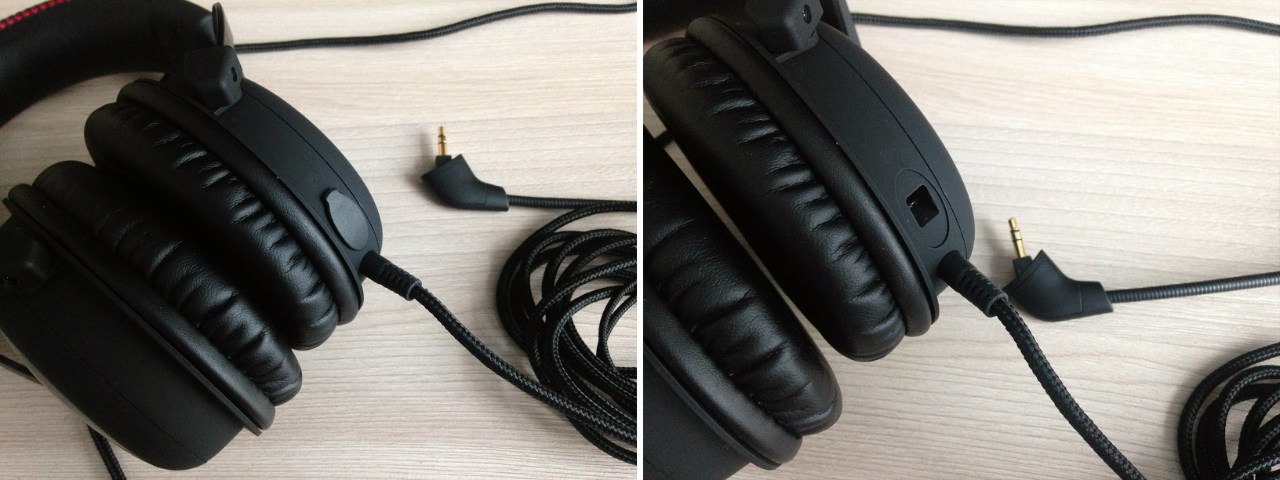
The microphone connects about the same place where the wire enters the left headphone cup, you first need to remove the cap. Blindly connecting a microphone is hard, because it has a specific jack (that is, the connector is normal, but it is hard to plug in), so you have to remove the headphones when the microphone is connected. He also does not retract anywhere and always hangs in front of his mouth, so talking and drinking gulls at the same time will not work, except to move him away from his mouth with the risk of being unheard by your interlocutor. And he does not turn off. So if the

You cannot buy a microphone separately, so in the event of a breakdown or loss you will most likely have no one to turn to. At least, it’s impossible to buy a microphone as a spare part for the time being. But, as it was said by the company itself, this possibility is being considered , and given the growth in popularity, this would be very useful. As well as the acquisition of the same ear cushions, bags for carrying and a set of various adapters and extension cords. Another thing is that you can order almost anything from our Chinese friends with AliExpress.
Headphones sometimes should be cleaned from dust, otherwise they are unpretentious in the care. On painted aluminum and on the soft-touch coating there are practically no traces (only from very dirty or greasy hands), therefore from time to time they need to be wiped with a damp cloth, and they will look like new.
The design of the headphones causes respect. Everything is very well assembled and fitted, visually the headphones look stylish and attractive, and most importantly, they sit comfortably on the head, do not put pressure on the ears, and in them I sat for hours on end. With them, even walking down the street is nice. But, as you know, in any headphones, appearance is not as important as sound, and therefore the most interesting part will be ahead.
And what about the sound? [ ↑ ]
Well, the headphones look beautiful, turn into a headset when you install the microphone, sit comfortably and in general, in general ... And what about the sound? After all, the headphones are taken, first of all, not for beauty, but for music, games and movies. And since they are positioned as a gaming headset, it should be understood that the emphasis here is placed on toys. But first things first.
Now and for the past few years I have been using Beyerdynamic DT 770 Pro 80 ohm headphones. It is clear that this is a completely different price category and the sound is different (but the nature of the sound, by the way, is somewhat similar), but at least it will be compared with something.
Music
I love electronics and something heavy. Mostly electronics, so the compositions were in most cases fast, powerful and bass. There was a place for vocals too, and I will, of course, write about this. I will omit the moment with the warming up of the headphones, because this is an individual thing and, let's say, unreliable, so that everyone will think about whether the headphones were warmed up or not. I'll just talk about the sound.
Only the music that I like to listen to (and I often listen to it) on my Beyerdynamic hit the tracklist. I listened to some of them a long time ago, and it was again pleasant to listen to these compositions. In any case, I heard all the features at once, and the nature of the sound from familiar compositions that sound differently due to these headphones is easier to describe. I will not go into the names of the performers and will only show genres. In each genre, I chose at least 2-3 tracks (more is better) and this turned out to be enough, in my opinion, to assess the quality of the headphones. Genres: electro and progressive house, drum and bass, disco nu, psi trance, glitch hop, trip hop, alternative rock, metal nude, chillout and dubstep.
Record quality: mp3, (cbr, 320 kbps), flac / wav.
Sound Source: Asus Maximus VI Hero (Realtek ALC1150)
In short, the sound impressions are positive, and they were only strengthened during the listening process.
Headphones play quite smoothly, there are no serious biases or differences in frequency, but here too there are some nuances. I did not find the frequency response of these headphones, so I will describe the sound itself (I don’t have the opportunity to make the frequency response myself). In general, the sound is very detailed, juicy, rich, but it sounds a bit “in the head”, that is, the scene is quite narrow. There is no feeling of a big stage, big space and surroundings around the listener. Some high and low bulge, and at first it was very noticeable, and then slowly I got used to it. But every rustle is more clearly audible, especially when it comes to live recording. That is, breathing, moving hands on the fingerboard and other small noise details (even parasitic ones) are very well visible. In particular, hissing and whistling sounds, flying off the vocalists' lips. As you understood, the higher the quality of the original records, the better. Headphone volume at a large, so lovers of "louder" is where to roam.
In general, the sound does not reach the hi-fi equipment with a more or less decent source, but it plays quite well, practicing its price. I also recommend using any sound card (LC) at least a basic level, like Asus Xonar DG / DGX (or slightly more expensive, like DX / DS / DSX - depending on the connection jack and the required characteristics) to fully reveal the potential of the headphones.
I have a fairly simple criterion for good-sounding headphones: if while listening to music or any other audio material nothing interferes or distracts, nothing gets out of the general volume level, then the headphones work as they should. Then you can describe it in very many words, take some criteria, but it is to some extent useless, because each of us perceives sound in our own way. I will say this: I believed the sound, which gives the HyperX Cloud. With some nuances, but it is. That is, after a long listening, completely immersed in the music and do not notice anything else around. And it speaks about the level of headphones.
Now, a little more detail.
The bass sounds a bit hollow, there is a “barrel” effect, but in general they play very well, although due to the close proximity of the speaker to the ears and the closed performance, there is a feeling that they stick out a bit from the sound range. But they play powerfully, driving, there is no feeling of swotting. For electronics and heavy tracks just right. Although the definition of "elastic" is also not always suitable for them - I want a softer bass, more rounded, or something. I want a little longer duration of the attack, so that the bass sounds softer.
Next come the high frequencies. Not average, and in the next paragraph you will understand why. The top is probably the weakest part of these headphones. In some cases, they act out sharply and quite noticeably stand out against the general background in some tracks / songs. In the tracks this is manifested in the form of strongly sounding cymbals (tts - tts - tts), in the songs - in whistling and hissing (css - tssss - fsh - slash and similar sounds). If it is electronic, then there is a feeling of “sand” - the top sounds unassembled in some tracks, as if they were scraping the ears. You get used to it too, but at first it is noticeable. Remember what I said about warming up? Everyone will have their own opinion. Maybe it's in the headphones, and maybe in the habit.
The middle frequencies play out exactly, but they ... are a little lost on the general background, if the volume is bass / middle / top in the same way. The top of the little bulge in the form of "placer", the bass sounds powerful, but the average - exactly. Without any embellishments and other things, but on the general background they are sometimes lacking, the feeling that they have gone somewhere to the background and they want a little more. And this is typical for songs where there is vocal (no matter whose and which one, but just where it is). In the tracks without words, everything sounds pretty balanced. One more thing: those instruments that have a wide reproduction range - viola, violin, trumpet or saxophone (where middle and high frequencies are involved, for example), play a little dry, as for me. Does not cling, if it's easier to talk Not in all compositions, of course, but in some of these instruments I did not like the sound.
Detailed description of one composition
I remember one of the compositions very well. I'm talking about the one that did not take over the soul. Lee Dewyze - Blackbird Song. Watched the walking dead? Remember her? Not? Listen up The vocals sound great here, but the alto is not set here. The tool is “broadband”, therefore exact reproduction is required on the whole range, and it turned out to be somewhat sluggish, even. At some point I characterized him squeaky. There is no feeling of a living instrument, not hooked. When I listened to him on my bares, I got goosebumps. But there is no here, although I did not listen to this recording for a very long time and for the first time in a long time I turned them on with these headphones. Therefore, there are still moments with which the headphones can not cope.
Yes, for the very reason that I can describe each track in this way, I didn’t give all the examples, otherwise the reading would be 2 times longer.
Yes, for the very reason that I can describe each track in this way, I didn’t give all the examples, otherwise the reading would be 2 times longer.
So there is a feeling that the bias in the frequency response is made on the bottoms and the top, while the middle is a little overwhelmed. At the same time, I sin on the built-in sound (I have no PCI slots on the motherboard, and therefore the only ZK I had with the PCI connector, I could not install and check), so with a more or less decent source, I think these flaws will be removed or smoothed out a bit.
Films
I honestly sat 2 films. And I did not notice how I spent them. I did not take off the headphones and completely immersed in what is happening. At the same time, and looked at what they could not reach. It is noteworthy that all the knocking sounds that I noticed in the process of captious listening, did not manifest themselves here. , , , , , , . . , , . .
Games
, HyperX Cloud , , . , , -: « ?»
. , , « ». . , , , . , , - . () .
« !» – . Right. , . , , , . (), .
CS GO , , . , , : , ( – , ). ( ) , . – , .
– 7.1. ? , . , , 7.1- (, , HyperX Cloud II – 7.1 ). , 5.1 . , . , 5.1 7.1 ( ), . , . .
- Dear, why do you hear so well?
- Honey, I'm just using the Kingston HyperX Cloud headset.
I didn’t expect this from headphones, but they ... play great on mobile devices. My sound source was the iPhone 5C. And its built-in sound module was enough to shake HyperX Cloud Core. The sound from them, of course, turned out worse than from a computer, which was expected, but the fact of using them as a portable headset says a lot.
. Skype, Facetime, . , , , . -, . -, . - – . , , :) . , , . , .
( , ), . , : . , . , .
. .
– *.wav. , , « ». Adobe Audition. +30.0 Db, . , +10 +20 Db. .
(, 16 , 44100 , 13 )
– iPhone 5C *.m4a.
(, 16 , 44100 , 420 )
[ ↑ ]
The headset was extremely versatile. She looks stylish, sits comfortably on her head, sounds good and clearly conveys the most important thing - her voice. She has good insulation and does not press on her head. Yes, and in the portable use of the headset has shown itself at its best. Agree to sit back in your chair and speak better than to pull a microphone to yourself separately. Impressions of the sound are only positive, even despite some flaws in playback. You get used to it and it gives pleasure. However, in my opinion, with such headphones it is advisable to use ZK at least an entry level.
HyperX Cloud, , – . , , -, . . , , 3 ( , – ), . , , : , , . - .
, , , . . Beyerdynamic, , . , , , . – , .
– 5000 . , . .
Pros:
- Assembly
- Materials
- Appearance
Minuses:
- Equipment
Features:
- Length of cable
- Ear cushions
Source: https://habr.com/ru/post/366231/
All Articles